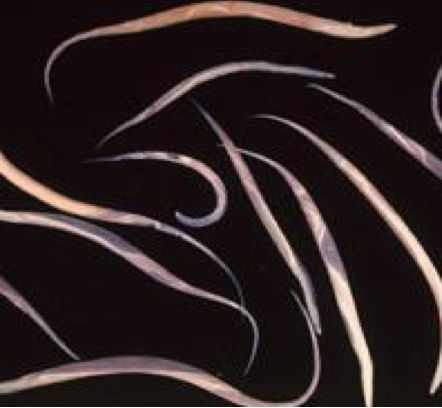Oxyuris equi (Pinworm) has had a UK wide increase in clinical cases recently and has become an issue in Orkney too.
The Life cycle
The life cycle of this nuisance worm is “direct” – the horse eats the infective larvae when eating, grooming or licking itself or others, and from their surroundings where the larvae have fallen or been rubbed off. These develop inside the intestines over the next 3-5 months until eventually the adult worms reach the rectum. From here egg-laden females protrude their tails through the anus to lay their eggs in a mass of sticky fluid onto the skin surface around the bottom. The eggs become infective in 3-5 days and then drop off into the environment to complete their life cycle. The ‘egg to egg’ period is 3-5 months, which seems to be shorter than it used to be in the past.

The fluid and eggs dry into a film 
Eggs under the microscope 
Adult worms
Pinworm infestation
Pinworm infestations may only involve a few adult worms. Infections are often more common in youngsters, compared with mature adult horses, which have developed better immunity, or older horses which might have age-related problems affecting their immune system.
Pinworm larvae may cause a low-grade irritation in the large bowel, and the egg fluid can cause skin irritation, but although they are a nuisance they are not usually life-threatening, unlike red worms or tapeworms can be.
Normal worm egg counts often do not pick up the eggs, which are not in the faeces but on the skin. Diagnosis can be made by looking for egg deposits around the anus, either visibly or using sellotape applied onto the skin around the anus and then examined under a microscope. Tail rubbing is another obvious sign.
Where does the itch come from?
Some individual horses seem to have a sensitivity to the eggs or fluid on the skin and can get irritated skin around their bottom, while others are unaffected.
Worming programmes
Some modern wormers are absorbed mainly in the small intestine and may not be reaching sufficient concentration in the large bowel to work for pinworms there, or some resistance may be occurring. If your horses have a pinworm problem, worming with a double dose of Strongid-P is more effective, and should be repeated after 5-6 weeks
Removing the eggs by cleaning your horse’s bottom is the best way of controlling pinworm.
Bathing the areas around the anus, the skin around about, and the dock, should be done with disposable materials – e.g. sensitive baby wipes, wet cotton wool – then thoroughly dried to prevent chapping. Contaminated wipes should be disposed of carefully. As eggs can become infective after 3-5 days the bathing should be repeated every third day. If a problem is occurring, then daily bathing is best. If the skin is irritated a dilute mild antiseptic can help. Applying Vaseline to the skin after cleaning can help protect the skin and prevent the eggs sticking. Some horses need veterinary medicines to help to kill larvae and treat the irritation.
Due to their sticky nature and resilience, removing eggs from the environment is extremely difficult and generally unsuccessful. However keeping grooming tools cleaned and separate, and scrubbing walls, posts etc. in the stable can help prevent spread.

